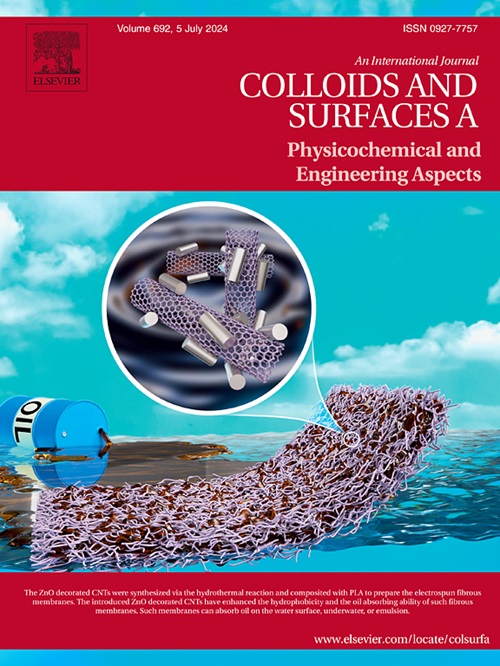Photoresponsive surfactants for controllable and reversible emulsion systems
IF 4.9
2区 化学
Q2 CHEMISTRY, PHYSICAL
Colloids and Surfaces A: Physicochemical and Engineering Aspects
Pub Date : 2024-10-29
DOI:10.1016/j.colsurfa.2024.135669
引用次数: 0
Abstract
Surfactants play a crucial role in applications such as oil-water separation, foam flotation, drug delivery, emulsion polymerization, and emulsifier recovery. Stimulus-responsive surfactants, as innovative smart materials, can reversibly control emulsion decomposition or phase transformation, facilitating emulsion circulation and component recovery. In this paper, two short-chain fluoroazobenzene photoresponsive surfactants (FADC-2 and FADC-4) were synthesized. Three different reversible emulsion systems were constructed, leveraging the excellent chemical stability and rapid photoresponse of azobenzene and the trifluoromethyl group as a hydrophobic moiety. The results indicate that under different light exposures, the FADC-2/n-hexane/water and FADC-4/n-hexane/water emulsions exhibit reversible emulsification and demulsification cycles, while the FADC-4/n-octanol/water emulsions show reversible phase transfer. These findings highlight the effectiveness of photoresponsive surfactants in controlled emulsion systems, offering promising applications in fields requiring precise emulsion manipulation and liquid-liquid phase transfer, at the same time advancing the development of environmentally friendly, practical, durable, and stimulus-responsive surfactants.
用于可控和可逆乳液体系的光致表面活性剂
表面活性剂在油水分离、泡沫浮选、药物输送、乳液聚合和乳化剂回收等应用中发挥着至关重要的作用。刺激响应型表面活性剂作为创新的智能材料,可以可逆地控制乳液分解或相变,促进乳液循环和成分回收。本文合成了两种短链氟偶氮苯光响应表面活性剂(FADC-2 和 FADC-4)。利用偶氮苯优异的化学稳定性和快速光响应性,以及三氟甲基作为疏水基团的特性,构建了三种不同的可逆乳液体系。结果表明,在不同的光照射条件下,FADC-2/正己烷/水和 FADC-4/ 正己烷/水乳液表现出可逆的乳化和反乳化循环,而 FADC-4/ 正辛醇/水乳液则表现出可逆的相转移。这些发现凸显了光致表面活性剂在可控乳液体系中的有效性,为需要精确乳液操作和液-液相转移的领域提供了广阔的应用前景,同时也推动了环保、实用、耐用和刺激响应型表面活性剂的发展。
本文章由计算机程序翻译,如有差异,请以英文原文为准。
求助全文
约1分钟内获得全文
求助全文
来源期刊
CiteScore
8.70
自引率
9.60%
发文量
2421
审稿时长
56 days
期刊介绍:
Colloids and Surfaces A: Physicochemical and Engineering Aspects is an international journal devoted to the science underlying applications of colloids and interfacial phenomena.
The journal aims at publishing high quality research papers featuring new materials or new insights into the role of colloid and interface science in (for example) food, energy, minerals processing, pharmaceuticals or the environment.

 求助内容:
求助内容: 应助结果提醒方式:
应助结果提醒方式:


